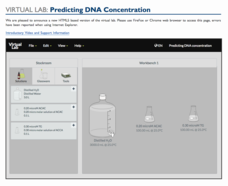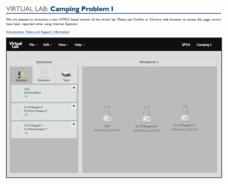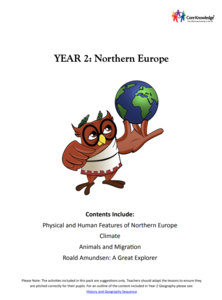Chemistry Collective
Virtual Lab: Temperature and the Solubility of Salts
Can your scholars solve the mystery of why salts dissolve? A virtual workbench allows them to experiment with temperature and solubility with no solution prep and no post-lab clean up! Users determine the solubility of a variety of...
Chemistry Collective
Virtual Lab: Determining the Solubility Product
No chemistry lab? No problem! Scholars use a virtual lab to determine the solubility product of four different chemicals. They then use the results of their experiments to see if higher solubility product values equal greater solubility.
Chemistry Collective
Virtual Lab: Unknown Silver Chloride
You'll need to concentrate on the concentration lab to get it done. Given a virtual beaker with a silver chloride solution of unknown concentration, scholars find the silver ion concentration in the solution. Of course, they must show...
Chemistry Collective
Virtual Lab: Exploring Oxidation-Reduction Reactions
All oxidation-reduction reactions can be reduced to a gain or loss of electrons. A two-part virtual lab first has users perform an experiment to order four metals from strongest to weakest reducing agent. It then requires aspiring...
Chemistry Collective
Virtual Lab: Glucose Dilution Problem
There's no diluted learning here! Young chemists conduct a virtual lab exploration to practice their stoichiometry skills. By manipulating simulated solutions, they create a solution of a specific glucose molarity.
Chemistry Collective
Virtual Lab: Acid Dilution Problem
There's no risk of injury when working with virtual HCl! Challenge your young chemists with making calculations to create a 3M solution of HCl from the concentrated acid. They first calculate the correct ratios of HCl and water and then...
Chemistry Collective
Virtual Lab: Cola and Sucrose Concentration Problem
Recreate the secret Coca-Cola formula in a virtual lab. Young scholars create the solution and then calculate sucrose concentrations in terms of percent mass, molarity, molality, and mole fraction. Then using density, learners determine...
Chemistry Collective
Virtual Lab: Making Stock Solutions from Solids
Combine a little solid and a little water and the solution is clear! An experimental lesson has individuals make calculations to create a sample solution of a given volume and molarity. They then create the solutions using a virtual lab...
Chemistry Collective
Virtual Lab: Alcohol Density Problem
Assume the role of Canadian border control! The percent of alcohol and density of a solution are related. Young scholars use this fact to classify solutions by their alcohol content to determine if they meet Canadian import laws.
Chemistry Collective
Virtual Lab: Gravimetric Determination of Arsenic
Arsenic in drinking water is a common problem in third world countries. Young chemists create a procedure to calculate the mass percent of arsenic in the soil. The virtual lab allows individuals to experiment with different methods.
Chemistry Collective
Virtual Lab: Determining Stoichiometric Coefficients
Investigate the reaction between four unknown substances using a virtual activity. Eager chemists examine the reaction between the four solutions to build a stoichiometric equation. The virtual workbench provides the tools necessary to...
Chemistry Collective
Virtual Lab: Stoichiometry and Solution Preparation Problem
Wow your classes with lesson that has a little of this and a little of that! Young chemists test their stoichiometry skills using a virtual laboratory setup. Using reaction information, they work to create a chemical reaction in which...
Chemistry Collective
Virtual Lab: Textbook Style Limiting Reagents Problems
Time to test the limits! Young scientists make limiting reagent calculations and test their math using a virtual lab simulation. Using their knowledge of ionic compounds, they determine the limiting reagents and the excess compounds.
Chemistry Collective
Virtual Lab: Textbook Style Limiting Reagents Problem II
Textbook problems with a twist! Young chemists analyze an ionic reaction to identify the limiting reagent. They then make calculations to determine the concentration of unknown solutions. Finally, they put their work to the test and...
Chemistry Collective
Virtual Lab: Predicting DNA Concentration
Play a little game of concentration! A virtual lab investigation allows learners to predict the products and reactants of a DNA reaction. They make their calculations and then test their predictions in the lab workbench.
Chemistry Collective
Virtual Lab: Unknown Concentration of DNA Solution Problem
Highlight DNA solution with fluorescent dyes! Scholars use dye to determine the concentration of a DNA solution. As the dyes bind with the DNA solution, learners make conclusions about the limiting reactants.
Chemistry Collective
Virtual Lab: Coffee Problem
Would you like milk with that? Young scientists consider thermal energy transfer to create the perfect cup of coffee. They calculate the amount of milk needed to reach a specified temperature and then test their calculations using a...
Chemistry Collective
Virtual Lab: Camping Problem I
Hiking chemists have an advantage! Young scholars use a virtual lab to conduct an experiment to create an exothermic reaction. The goal is to create enough heat to warm a meal during a hike in the rain.
Chemistry Collective
Virtual Lab: Camping Problem II
What happens to the enthalpy of a reaction as the concentration of reactants varies? Learners explore this question with a virtual lab activity. They consider five different solutions of the same reactants and monitor the temperature...
Leadership Challenge
Inspire Students Today to Make a Difference in the Future
Your search for a year's worth of leadership lessons is over! A lesson in a character education series provides a full two semesters of inspiring leadership activities. The resource includes individual and group challenges to ensure a...
Houghton Mifflin Harcourt
Nature: Friend and Foe: Extra Support Lessons (Theme 6)
Breaking down words into syllables has two benefits: it improves vocabulary and it improves understanding of a text. The third and final resource in a series of materials designed to be used with Nature: Friend or Foe offers extra...
Core Knowledge Foundation
Year 2: Northern Europe
How is life in Northern Europe different from other areas of the world? Historians journey through the various regions of Northern Europe discovering what type of climate, animals, and lifestyles exist in that section of the world. They...
Reed Novel Studies
Mr. Popper's Penguins: Novel Study
Antarctica is actually a desert. Using the novel study that explores Mr. Popper's Penguins, pupils find four of their own interesting facts about the amazing continent. They also practice putting words in alphabetical order and answer...
Hildegard Center for the Arts
Mardi Gras Masks
Laissez les bons temps rouler! Create your own festive Mardi Gras masks with a lesson that provides background information on the celebration and instructions about constructing the masks.
Other popular searches
- Early Explorers
- Spanish Explorers
- European Explorers
- English Explorers
- Ocean Explorers
- Early European Explorers
- Early American Explorers
- Australian Explorers
- World Famous Explorers
- Explorers for Grade 3
- European Explorers in Texas
- Early Explorers Map Skills

























